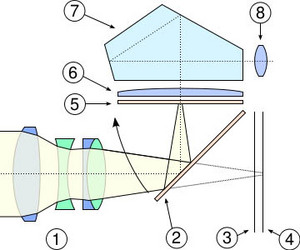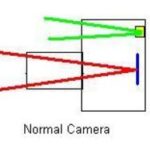A camera prism is a component of a SLR camera. The most common type of camera prism is the roof pentaprism which refracts light in such a way as to allow the photographer to see the actual image being captured through the camera’s viewfinder. A camera’s prism is located inside of the camera near the top and is made of transparent material.
Before you can understand how a camera prism works you have to have a basic understanding of how a camera takes a picture. The very first camera was the camera obscura which was developed sometime between 390BC and 470BC. A camera obscura was a totally dark room. It could be as small as a box or as large as a house. One wall was blank; the opposite wall had a small hole through which light could come through. As light enters the hole an image of the setting outside the box can be seen on the inside blank wall. Before film the artist would trace the image on a piece of paper. The image would always be upside down. The same concept applies to the pinhole camera except instead of a piece of paper the “blank wall” is a piece of film. The light sensitive chemicals in the film react to the light by creating a negative image that can later be developed into a photograph.
Later as the camera became more complex mirrors were added to reverse the image before it reached the film, lenses were added to concentrate light and create clearer images, shutters were added to control the amount of light that entered the camera, and the viewfinder was added so that the photographer could a more accurate idea of the image he or she was about to take.
A viewfinder is like a reverse telescope mounted on or in the camera that the photographer can look through to compose (or focus) the photograph. This works fine when subjects are mid range but makes taking pictures of far away or close up images more difficult. Often what the photographer sees in the viewfinder and what the camera takes a picture of are slightly different. The SLR camera with its internal camera prism was designed to solve this issue.
A prism is a transparent object with one highly polished side that is used to refract (change the direction of) light. We are most familiar with triangle prisms used to separate white light into a rainbow of colored light, but prisms come in a variety of shapes and sizes. The prisms inside most cameras are roof pentaprisms. A roof prentaprism is a prism with five sides that is capable of refracting the light left to right. This prism is a major part of the Single Reflex Camera (SLR). SLR cameras differ from traditional point and shoot cameras because they use an automatic moving mirror and a pentaprism to direct light from the lens to the viewfinder so that the photographer sees the same image as the camera.
As light enters the camera through the lens in the front of the camera it travels towards the back of the camera. Before reaching the back of the camera the light is reflected by a mirror at a 90 degree angle. The light is now pointing towards the top of the camera. The light goes through a filtering screen and condenser lens before striking the camera’s prism. When the light hits the camera’s prism (remember the light is still pointing to the top of the inside of the camera) it hits the top of the prism and is refracted at a 45 degree angle down towards the front of the camera where it hits another prism surface and is refracted towards the back of the camera and through the viewfinder. The photographer can then see the image as it actually appears through the camera. The camera prism makes this possible. When a photograph is taken the mirror is automatically moved to allow light to strike the back of the camera where the film resides.



